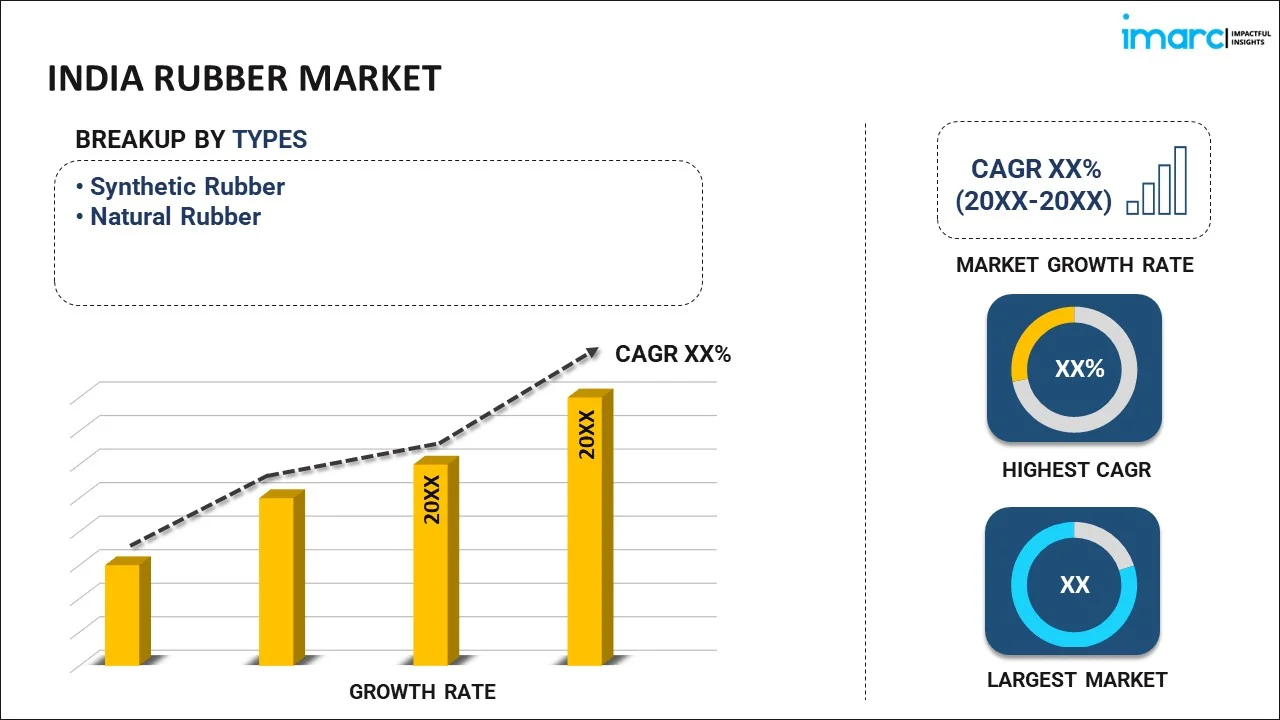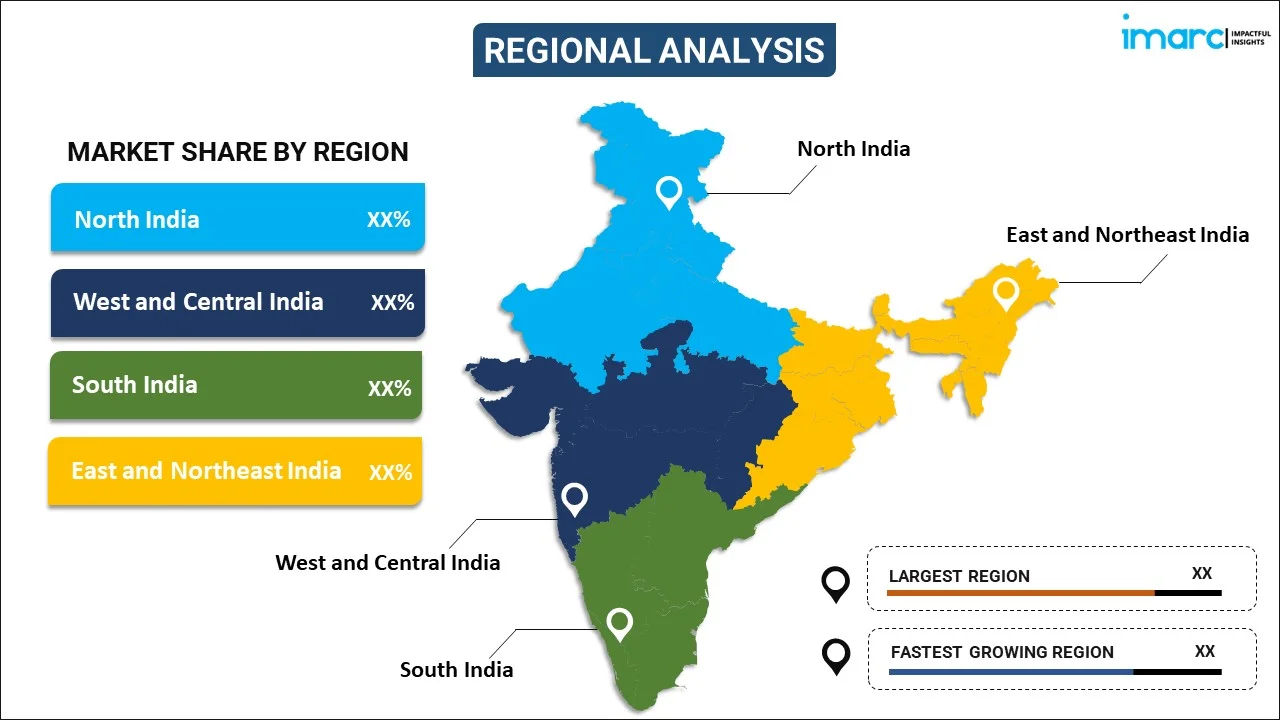
India Rubber Market Report by Type (Synthetic Rubber, Natural Rubber), Application (Tire, Non-Tire Automotive, Footwear, Industrial Goods, and Others), and Region 2025-2033
Market Overview:
India rubber market size is projected to exhibit a growth rate (CAGR) of 3.90% during 2025-2033. The increasing innovations in synthetic rubber production, along with the development of high-performance rubber compounds, are driving the market.
|
Report Attribute
|
Key Statistics
|
|---|---|
|
Base Year
|
2024 |
|
Forecast Years
|
2025-2033
|
|
Historical Years
|
2019-2024
|
| Market Growth Rate (2025-2033) | 3.90% |
Rubber, a versatile and resilient polymer derived from the latex sap of rubber trees, has played a pivotal role in various aspects of modern life. Its unique properties, including elasticity and waterproofing, make it indispensable in countless applications. The automotive industry relies heavily on rubber for tires, ensuring safe and smooth transportation. Additionally, the manufacturing sector utilizes rubber in conveyor belts, gaskets, and seals, benefiting from its durability and flexibility. Beyond industry, everyday items such as erasers, footwear, and medical gloves are made possible by this remarkable material. Rubber's ability to absorb shock and resist wear has also found applications in sports equipment and flooring. As a sustainable resource, rubber harvesting promotes economic growth in regions with rubber plantations.
India Rubber Market Trends:
The rubber market in India is significantly influenced by various interconnected factors, each playing a crucial role in shaping its dynamics. Firstly, the regional automotive industry serves as a primary driver, directly impacting the demand for rubber in the production of tires and automotive components. Additionally, economic growth and industrialization contribute to increased vehicle production, thereby fueling the demand for rubber. Moreover, weather conditions and natural disasters, such as typhoons and hurricanes, can disrupt rubber plantations, affecting the overall supply and leading to fluctuations in market prices. Furthermore, environmental concerns and sustainability initiatives are emerging as influential forces in the rubber market. With a growing emphasis on eco-friendly practices, there is a rising demand for sustainable and ethically sourced rubber, driving market players to adopt environmentally responsible production methods. In tandem, technological advancements in rubber cultivation and processing contribute to increased efficiency and product quality, shaping the market landscape. Geopolitical events and trade policies also play a role, as they can impact the regional supply chain and trade dynamics of rubber. In essence, the rubber market in India is a complex web of interconnected factors, where shifts in one area can reverberate throughout the entire industry.
India Rubber Market Segmentation:
IMARC Group provides an analysis of the key trends in each segment of the market, along with forecasts at the country level for 2025-2033. Our report has categorized the market based on type and application.
Type Insights:

- Synthetic Rubber
- Natural Rubber
The report has provided a detailed breakup and analysis of the market based on the type. This includes synthetic rubber and natural rubber.
Application Insights:
- Tire
- Non-Tire Automotive
- Footwear
- Industrial Goods
- Others
A detailed breakup and analysis of the market based on the application have also been provided in the report. This includes tire, non-tire automotive, footwear, industrial goods, and others.
Regional Insights:

- North India
- West and Central India
- South India
- East and Northeast India
The report has also provided a comprehensive analysis of all the major regional markets, which include North India, West and Central India, South India, and East and Northeast India.
Competitive Landscape:
The market research report has also provided a comprehensive analysis of the competitive landscape in the market. Competitive analysis such as market structure, key player positioning, top winning strategies, competitive dashboard, and company evaluation quadrant has been covered in the report. Also, detailed profiles of all major companies have been provided.
India Rubber Market Report Coverage:
| Report Features | Details |
|---|---|
| Base Year of the Analysis | 2024 |
| Historical Period | 2019-2024 |
| Forecast Period | 2025-2033 |
| Units | Million USD |
| Scope of the Report | Exploration of Historical Trends and Market Outlook, Industry Catalysts and Challenges, Segment-Wise Historical and Future Market Assessment:
|
| Types Covered | Synthetic Rubber, Natural Rubber |
| Applications Covered | Tire, Non-Tire Automotive, Footwear, Industrial Goods, Others |
| Regions Covered | North India, West and Central India, South India, East and Northeast India |
| Customization Scope | 10% Free Customization |
| Post-Sale Analyst Support | 10-12 Weeks |
| Delivery Format | PDF and Excel through Email (We can also provide the editable version of the report in PPT/Word format on special request) |
Key Questions Answered in This Report:
- How has the India rubber market performed so far and how will it perform in the coming years?
- What has been the impact of COVID-19 on the India rubber market?
- What is the breakup of the India rubber market on the basis of type?
- What is the breakup of the India rubber market on the basis of application?
- What are the various stages in the value chain of the India rubber market?
- What are the key driving factors and challenges in the India rubber?
- What is the structure of the India rubber market and who are the key players?
- What is the degree of competition in the India rubber market?
Key Benefits for Stakeholders:
- IMARC’s industry report offers a comprehensive quantitative analysis of various market segments, historical and current market trends, market forecasts, and dynamics of the India rubber market from 2019-2033.
- The research report provides the latest information on the market drivers, challenges, and opportunities in the India rubber market.
- Porter's five forces analysis assist stakeholders in assessing the impact of new entrants, competitive rivalry, supplier power, buyer power, and the threat of substitution. It helps stakeholders to analyze the level of competition within the India rubber industry and its attractiveness.
- Competitive landscape allows stakeholders to understand their competitive environment and provides an insight into the current positions of key players in the market.
Need more help?
- Speak to our experienced analysts for insights on the current market scenarios.
- Include additional segments and countries to customize the report as per your requirement.
- Gain an unparalleled competitive advantage in your domain by understanding how to utilize the report and positively impacting your operations and revenue.
- For further assistance, please connect with our analysts.
 Inquire Before Buying
Inquire Before Buying
 Speak to an Analyst
Speak to an Analyst
 Request Brochure
Request Brochure
 Request Customization
Request Customization




.webp)




.webp)












